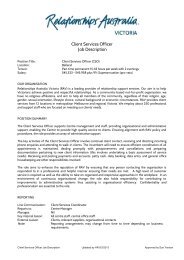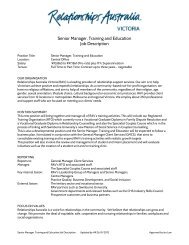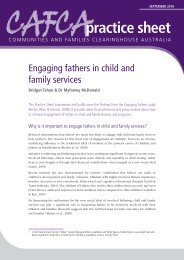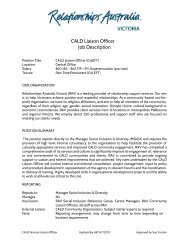Developing a Vietnamese Men's Behaviour Change Program
Developing a Vietnamese Men's Behaviour Change Program
Developing a Vietnamese Men's Behaviour Change Program
Create successful ePaper yourself
Turn your PDF publications into a flip-book with our unique Google optimized e-Paper software.
Project outcomes: a discussionThe three key proposed outcomes of this project were:1. Decreased prevalence of violence within the families of the men participating in thegroup as evidenced by the men’s partners through women’s stories that theviolence has decreased.2. Increased access to support and relevant services for <strong>Vietnamese</strong> speakingwomen and children who have experienced family violence and for the <strong>Vietnamese</strong>men who have used the family violence.3. Increased learning in relation to family violence with the targeted CALD communityby the reference group, which may assist the partners in including new practicesinto work that would further enhance our work with men and our work around thesafety of women and children.Outcomes 1 and 2In order to measure outcomes 1 and 2, the men were asked to complete a survey abouttheir violent behaviour and their control over it at the beginning, middle and end of thegroup.The partner contact worker recorded information from the women at three stages through anarrative approach and when appropriate for the women, rather than at a prescribed time.The discussion is based on the findings of these surveys, the reference group insights andthe understanding of the men and their partners gained by the workers who worked closelywith them and conducted the initial assessment.The survey results are taken from the responses of the nine men who completed the group(as one of these men ticked disagree for every question in every evaluation, his results wereomitted).The women’s survey results are taken from the five women with whom the partner contactworker had regular contact and for whom the surveys were appropriate and useful toimplement.In the early stages of the group, the facilitators’ experience of the men was of denial andminimisation of violent behaviour, leading to gradual recognition and disclosure of violentbehaviour.The men’s responses to the ‘reflections on his behaviour’ table support this, in that thereis a general pattern of responses constituted by the men responding ‘not relevant ( neverhappened)’ to the use of all violent behaviours at the beginning of the group and yetresponding ‘noticeable change for the better’ for all behaviours at the end.There was variation in the women’s responses to the question of how likely they thoughtthat the man would injure them again and wariness about their safety half way through9














